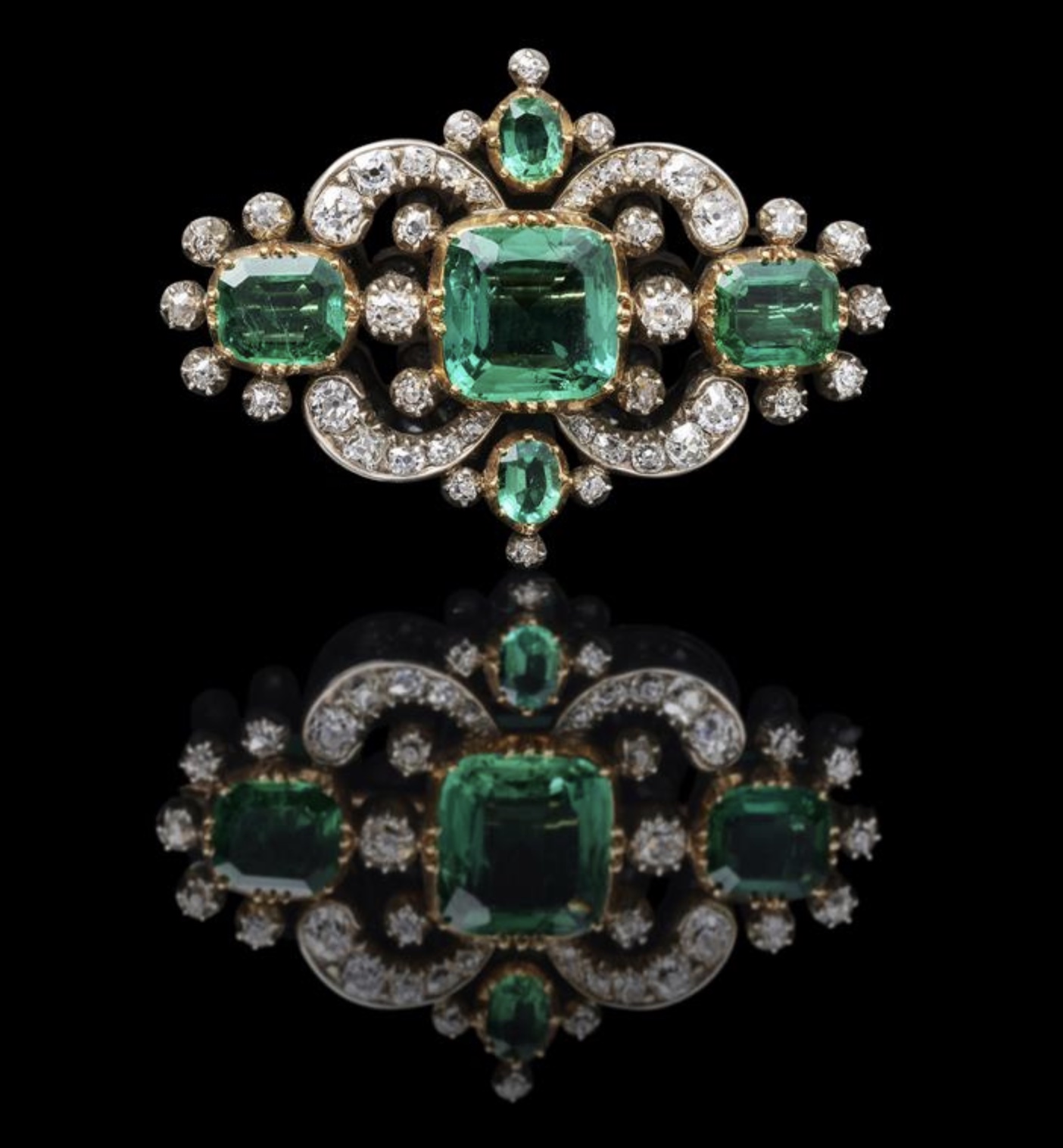#Royal #Regency #emerald #diamond #brooch #sale #Antique #Collecting
 A historically important Regency emerald and diamond brooch that belonged to Her Royal Highness Princess Charlotte of Wales (1796–1817), is set to head to auction in July.
A historically important Regency emerald and diamond brooch that belonged to Her Royal Highness Princess Charlotte of Wales (1796–1817), is set to head to auction in July.
The Princess, who would have gone on to become the British monarch, died prematurely during childbirth in 1817. The brooch was then kindly given by the Princess’ husband (Prince Leopold of Saxe Coburg, who later became King Leopold I, the first King of the Belgians), to the Princess’ lady of the bedchamber, Mary Anne John Thynne, Baroness Carteret (D. 1863), where it remained within her family, passing down through generations until now.

The story of the brooch is found inside an accompanying Regency fitted ebony box, which has a gold plaque bearing the inscription: This broach belonged to Her Royal Highness Princess Charlotte Augusta, Obt 6 Nov 1817 at 22, & on her lamented demise, was the kind and valued gift of Her Consort, Prince Leopold of Saxe Coburg to Mary Anne John Thynne, one of H.R.Hs ladies of the bedchamber, in attendance on that afflicting event, whose wish it is, that it should descend unalter’d to posterity, in lasting and grateful remembrance of its former beloved & illustrious possessor.
Princess Charlotte Augusta was born in London, on 7 January 1796, the only child of the Prince of Wales and Caroline of Brunswick. As her father Prince George was the sole legitimate heir of George III, Charlotte was the heir presumptive to the British throne. After her parents separated in 1798, her father took formal guardianship of Charlotte, together with her grandparents, King George III and Queen Charlotte.
In 1816, Charlotte married Leopold of Saxe-Coburg-Saalfeld, (later King Leopold I, the first King of the Belgians). The young Royal couple led a predominantly idyllic life at Claremont House in Surrey, but their happiness was tragically cut short when Charlotte died. She had become extremely popular with the public and her death sparked deep mourning throughout Britain, not dissimilar to that of Diana, Princess of Wales. A mourning period set in with shops closing for two weeks, alongside the law courts, docks and even the Royal Exchange. Fabric shops ran out of black fabric and those who couldn’t afford mourning clothes tied black fabric around their arms.
The Princess was buried with her son at her feet, in St. George’s Chapel at Windsor Castle. A monument to her was created by the sculptor Matthew Cotes Wyatt and later an obelisk was erected in memory of her by the then Liberal MP for Walsall, Robert Wellbeloved Scott, in the grounds of his country house (now Red House Park, in Sandwell, West Midlands).
A kind gesture on Charlotte’s death by her husband, saw the brooch go to the Princess’ lady of the bedchamber, Mary Anne John Thynne, Baroness Carteret (D. 1863). She was the third daughter of Thomas Master, the MP for Cirencester. In 1801 she married John Thynne, later 3rd Baron Carteret of Hawnes (1772-1849), son of Thomas Thynne, 1st Marquess of Bath and Lady Elizabeth Cavendish-Bentinck. John Thynne was Vice Chamberlain of the Household at the court of George III and Mary Ann was appointed Lady of the Bedchamber to Princess Charlotte from 1815, until her death in 1817.
As Lady of the Bedchamber, Mary Anne was with Princess Charlotte throughout her two-day labour which resulted in the birth of her still born son, followed by her own death in the early hours of 6th November 1817. There must have been an affinity between the two women for her to have received such a precious gift. It was also obviously treasured as it remained with her family until now. After the death of Princess Charlotte she became Lady of the Bedchamber to Princess Sophia (1777-1848). In 1838 her husband inherited the title 3rd Baron Carteret of Hawnes, and she became Baroness Carteret. Mary Anne died in 1863 aged 86.
James Nicholson, Head of Dreweatts Jewellery department, said: “This is a jewel of extraordinary historical importance interwoven into the story of Britain and its Royal Family. Had Princess Charlotte and her son lived, they would have gone on to inherit the British throne after the Prince Regen (later King George III). This would have meant no Queen Victoria, or her descendants sitting on the British throne and our Royal Family might look very different today. The colour of the emeralds in the brooch are truly mesmerising and seated in its box with the inscribed gold lid, it is without doubt an exceptional piece.”
The brooch is set with a central squared cushion-cut Colombian emerald estimated to weigh 2.47 carats. It also features step cut and oval cut emeralds to the cardinal points, claw set in gold cut down collets, with old mine cut diamond scrolls and cut down collet set diamond accents. The brooch will be offered in a auction of Fine Jewellery, Silver, Watches and Objects of Vertu on July 12.
It carries an estimate of £10,000-£15,000.




